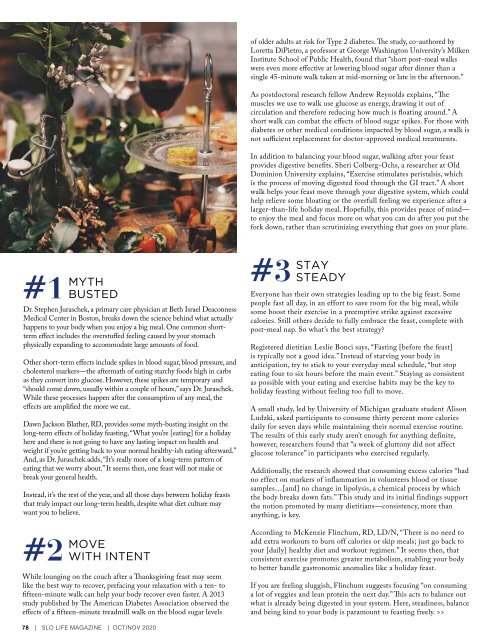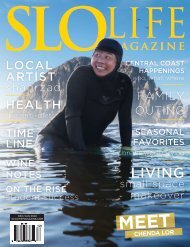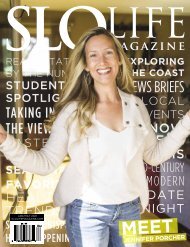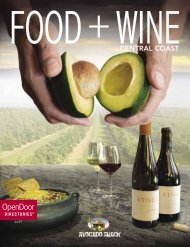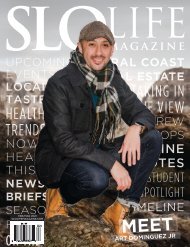SLO LIFE Oct/Nov 2020
You also want an ePaper? Increase the reach of your titles
YUMPU automatically turns print PDFs into web optimized ePapers that Google loves.
of older adults at risk for Type 2 diabetes. The study, co-authored by<br />
Loretta DiPietro, a professor at George Washington University’s Milken<br />
Institute School of Public Health, found that “short post-meal walks<br />
were even more effective at lowering blood sugar after dinner than a<br />
single 45-minute walk taken at mid-morning or late in the afternoon.”<br />
As postdoctoral research fellow Andrew Reynolds explains, “The<br />
muscles we use to walk use glucose as energy, drawing it out of<br />
circulation and therefore reducing how much is floating around.” A<br />
short walk can combat the effects of blood sugar spikes. For those with<br />
diabetes or other medical conditions impacted by blood sugar, a walk is<br />
not sufficient replacement for doctor-approved medical treatments.<br />
In addition to balancing your blood sugar, walking after your feast<br />
provides digestive benefits. Sheri Colberg-Ochs, a researcher at Old<br />
Dominion University explains, “Exercise stimulates peristalsis, which<br />
is the process of moving digested food through the GI tract.” A short<br />
walk helps your feast move through your digestive system, which could<br />
help relieve some bloating or the overfull feeling we experience after a<br />
larger-than-life holiday meal. Hopefully, this provides peace of mind—<br />
to enjoy the meal and focus more on what you can do after you put the<br />
fork down, rather than scrutinizing everything that goes on your plate.<br />
#1<br />
MYTH<br />
BUSTED<br />
Dr. Stephen Juraschek, a primary care physician at Beth Israel Deaconness<br />
Medical Center in Boston, breaks down the science behind what actually<br />
happens to your body when you enjoy a big meal. One common shortterm<br />
effect includes the overstuffed feeling caused by your stomach<br />
physically expanding to accommodate large amounts of food.<br />
Other short-term effects include spikes in blood sugar, blood pressure, and<br />
cholesterol markers—the aftermath of eating starchy foods high in carbs<br />
as they convert into glucose. However, these spikes are temporary and<br />
“should come down, usually within a couple of hours,” says Dr. Juraschek.<br />
While these processes happen after the consumption of any meal, the<br />
effects are amplified the more we eat.<br />
Dawn Jackson Blather, RD, provides some myth-busting insight on the<br />
long-term effects of holiday feasting, “What you’re [eating] for a holiday<br />
here and there is not going to have any lasting impact on health and<br />
weight if you’re getting back to your normal healthy-ish eating afterward.”<br />
And, as Dr. Juraschek adds, “It’s really more of a long-term pattern of<br />
eating that we worry about.” It seems then, one feast will not make or<br />
break your general health.<br />
Instead, it’s the rest of the year, and all those days between holiday feasts<br />
that truly impact our long-term health, despite what diet culture may<br />
want you to believe.<br />
#2<br />
MOVE<br />
WITH INTENT<br />
While lounging on the couch after a Thanksgiving feast may seem<br />
like the best way to recover, prefacing your relaxation with a ten- to<br />
fifteen-minute walk can help your body recover even faster. A 2013<br />
study published by The American Diabetes Association observed the<br />
effects of a fifteen-minute treadmill walk on the blood sugar levels<br />
#3<br />
STAY<br />
STEADY<br />
Everyone has their own strategies leading up to the big feast. Some<br />
people fast all day, in an effort to save room for the big meal, while<br />
some boost their exercise in a preemptive strike against excessive<br />
calories. Still others decide to fully embrace the feast, complete with<br />
post-meal nap. So what’s the best strategy?<br />
Registered dietitian Leslie Bonci says, “Fasting [before the feast]<br />
is typically not a good idea.” Instead of starving your body in<br />
anticipation, try to stick to your everyday meal schedule, “but stop<br />
eating four to six hours before the main event.” Staying as consistent<br />
as possible with your eating and exercise habits may be the key to<br />
holiday feasting without feeling too full to move.<br />
A small study, led by University of Michigan graduate student Alison<br />
Ludzki, asked participants to consume thirty percent more calories<br />
daily for seven days while maintaining their normal exercise routine.<br />
The results of this early study aren’t enough for anything definite,<br />
however, researchers found that “a week of gluttony did not affect<br />
glucose tolerance” in participants who exercised regularly.<br />
Additionally, the research showed that consuming excess calories “had<br />
no effect on markers of inflammation in volunteers blood or tissue<br />
samples…[and] no change in lipolysis, a chemical process by which<br />
the body breaks down fats.” This study and its initial findings support<br />
the notion promoted by many dietitians—consistency, more than<br />
anything, is key.<br />
According to McKenzie Flinchum, RD, LD/N, “There is no need to<br />
add extra workouts to burn off calories or skip meals; just go back to<br />
your [daily] healthy diet and workout regimen.” It seems then, that<br />
consistent exercise promotes greater metabolism, enabling your body<br />
to better handle gastronomic anomalies like a holiday feast.<br />
If you are feeling sluggish, Flinchum suggests focusing “on consuming<br />
a lot of veggies and lean protein the next day.” This acts to balance out<br />
what is already being digested in your system. Here, steadiness, balance<br />
and being kind to your body is paramount to feasting freely. >><br />
78 | <strong>SLO</strong> <strong>LIFE</strong> MAGAZINE | OCT/NOV <strong>2020</strong>


